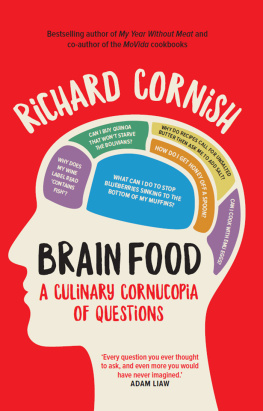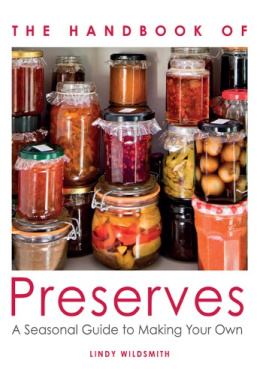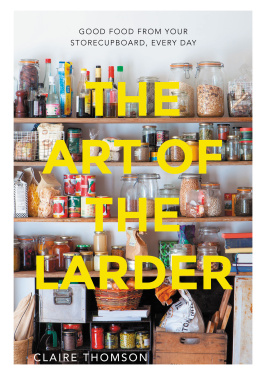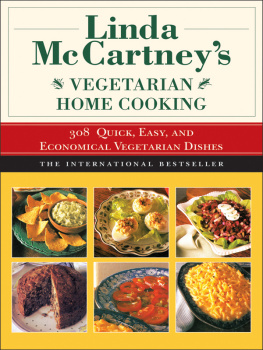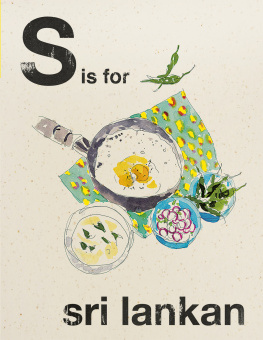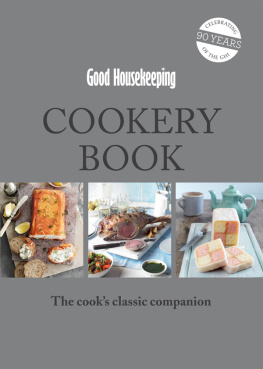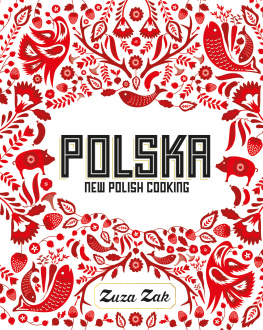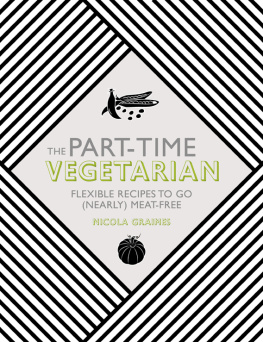Cornish - Brain Food
Here you can read online Cornish - Brain Food full text of the book (entire story) in english for free. Download pdf and epub, get meaning, cover and reviews about this ebook. City: Carlton;Vic, year: 2017, publisher: Melbourne University Publishing, genre: Home and family. Description of the work, (preface) as well as reviews are available. Best literature library LitArk.com created for fans of good reading and offers a wide selection of genres:
Romance novel
Science fiction
Adventure
Detective
Science
History
Home and family
Prose
Art
Politics
Computer
Non-fiction
Religion
Business
Children
Humor
Choose a favorite category and find really read worthwhile books. Enjoy immersion in the world of imagination, feel the emotions of the characters or learn something new for yourself, make an fascinating discovery.
- Book:Brain Food
- Author:
- Publisher:Melbourne University Publishing
- Genre:
- Year:2017
- City:Carlton;Vic
- Rating:4 / 5
- Favourites:Add to favourites
- Your mark:
- 80
- 1
- 2
- 3
- 4
- 5
Brain Food: summary, description and annotation
We offer to read an annotation, description, summary or preface (depends on what the author of the book "Brain Food" wrote himself). If you haven't found the necessary information about the book — write in the comments, we will try to find it.
Cornish: author's other books
Who wrote Brain Food? Find out the surname, the name of the author of the book and a list of all author's works by series.
Brain Food — read online for free the complete book (whole text) full work
Below is the text of the book, divided by pages. System saving the place of the last page read, allows you to conveniently read the book "Brain Food" online for free, without having to search again every time where you left off. Put a bookmark, and you can go to the page where you finished reading at any time.
Font size:
Interval:
Bookmark:
BRAIN FOOD
RICHARD CORNISH

MELBOURNE UNIVERSITY PRESS
An imprint of Melbourne University Publishing Limited
Level 1, 715 Swanston Street, Carlton, Victoria 3053, Australia
www.mup.com.au
First published 2017
Text Richard Cornish, 2017
Design and typography Melbourne University Publishing Limited, 2017
This book is copyright. Apart from any use permitted under the Copyright Act 1968 and subsequent amendments, no part may be reproduced, stored in a retrieval system or transmitted by any means or process whatsoever without the prior written permission of the publishers.
Every attempt has been made to locate the copyright holders for material quoted in this book. Any person or organisation that may have been overlooked or misattributed may contact the publisher.
The author would like to thank Greg and Lucy Malouf, Victoria Heywood, Rosa Mitchell, Stephanie Alexander and Phillippa Grogan (with whom he wrote Phillippas Home Baking) for their recipes, used in Brain Food as benchmarks.
Text design and typesetting by Megan Ellis
Cover design by Philip Campbell Design
Printed in Australia by McPhersons Printing Group
National Library of Australia Cataloguing-in-Publication entry
Cornish, Richard, 1967author.
Brain food/Richard Cornish.
9780522871128 (paperback)
9780522871135 (ebook)
CookingMiscellanea.
Food writing.
The author would like to thank the following people. Veronica Ridge, Jane Willson, Janne Apelgren, Ros Grundy, Nina Rousseau, Ardyn Bernoth, Nedahl Stelio, The Team at MUP and the hundreds of readers who have contributed to the Brain Food questions over the years and who continue to do so. Sophie, Mary, Nerida, Frank and Maxthanks. Thanks to my partner Tiffany Treloar and daughters Ginger and Sunday for their unconditional love and hot cups of tea.
It was April 2016. A phone call from the editor of what was then called The Age Epicure (now Good Food) confirmed the news that I had long anticipated. My Brain Food column had been axed and had just a few weeks to run. The tongue-in-cheek food Q-and-A column had not been getting traction online. It was decided, purely on numbers, to ditch it. To me it was no wonder. The column had been invented to run on a newspaper page with a headline and strapline that flagged to the reader that while the information was relevant and accurate, the tone was irreverent and ironic.
It had been devised seven years earlier, with myself and the editor of the food section of the Melbourne Age at the time, Veronica Ridge, both out to a long lunch. At the end of several bottles we both had tears in our eyes. We were sick to death of the deadly serious tone of most food media. We wanted to have a laugh. We wanted to have fun with the concepts of food, cooking and dining while still delivering down-to-earth and common-sense information. We wanted to embrace the burgeoning flow of food-related science coming from research bodies and tie it back to old-fashioned values. We wanted to do it with a voice that did not care about offending people in the short term, instead offering a place in the paper that was slightly offbeat, humorous and informative.
When I said goodbye in my final column I had no idea that the voice and persona that had been hatched at a well-known Italian restaurant and then the public bar of Young and Jacksons some seven years earlier had gained a strong following. Not just a few fans but a phalanx of avid readers. They took to social media, email and old-fashioned Basildon Bond to voice their protest. It is the reason I buy the Tuesday paper, was the gist of the letters. About a thousand of them. That is a lot. Within a few days the powers that be yielded to the voice of the masses and reinstated the column.
What you are about to read is a selection of some of the best columns that appeared in print from 2010 to 2016. Some have been edited to include additional information or update details. Following some of the answers are Letters, Corrections and Apologiesa readers right of reply the column took on board the week following a dispute or comment.
To answer the question I always get asked: yes, all the questions, bar a few exceptions, have been sent in by readers. Sometimes a topical query will pop up from a member of the food community, most often my neighbours. I will take their query and turn it into a Dorothy Dixer. Look out for the name S. Allen. She is my daughters godmother. Often I will amend grammar, rewrite the question to make it a feed line for a gag or add a name when the person fails or refuses to give their first initial and surname. When annoying people write in with grammatical errors or typos I deliberately leave them so I can add the passive aggressive [sic], meaning that is what they wrote exactly, letter for letter, even if it is wrong. Where the column has evoked a response that was published I have included it as well.
The tone was established from the outset. It was to be irreverent, not only of the subject matter but the readers themselves. This went as far as correcting poor grammar and leaving in typographical errors to make a point when necessary. Some readers found this disconcerting and wrote abusive letters. Others loved the tone and goaded me on. This allowed a live correspondence with the readers. Here is an example:
Though we appreciate all your correspondence equally, we find some more equal than others, such as this letter from a reader. On first noticing your column a few years ago, I was struck, not to say thrilled, when I observed a certain superior to thou tone, a veritable de haut en bas approach to the readers, huddled, as they are, in their grubby democracy. Over several years, you have softened your manner towards the stupid and the ignorant, thus inducing me to read you less frequently.
So, remove tight-fitting clothing. Pour yourself a cup of tea or a large glass of wine. Take a seat in a comfortable chair. Put your feet on a comfortable stool or cushion and enter the world of Brain Food.
For generations, baking skills were passed down from elder to younger in kitchens across the nation. An unbroken chain of information transfer developed over centuries has been truncated in just a few decades. Questions about flour, butter, sugar and yeast that were once uttered around a floury kitchen bench have been silenced by packet cake mix and suburban baking franchises. Thankfully the deep urge to bake is re-emerging in the new generation. The readers generally give me a lot more detail than just their name. They often tell me a lot about themselves, where they come from and what they do for a living. I know that many of the emails I receive come from students, and from the names and spidery cursive signatures on those written in ink, I assume that many of the other queries are written by older people who were born in Europe many decades ago.
Whatever the case, the writers always provide their Christian names, something that is quickly redacted prior to publication, so I often refer to them as Good Sir or Dear Lady. It is a pleasure to help those who feel their life is incomplete without baking skills to accomplish something fulfillingeven if it is just a fluffy scone.
When making a cake, should I sift the flour? P. Lim
There are two schools of thought on siftingsome would say its a kitchen schism. Sifting used to be almost compulsory as bits of bran and wheat stem would get through the milling process. Flour was also too damp and would clump. The modernists say that you dont need to sift flour any more because contemporary milling and packaging is so good that flour is pure and doesnt clump. The traditionalists say that sifting dry ingredients mixes them together better, aerates them and creates a lighter mix. The traditionalists also like the sound the old sifters make as their metal agitators move over the steel mesh. I had to go to a higher court on this one. My mum makes the best sponges in the world and she says sift. So that settles that.
Next pageFont size:
Interval:
Bookmark:
Similar books «Brain Food»
Look at similar books to Brain Food. We have selected literature similar in name and meaning in the hope of providing readers with more options to find new, interesting, not yet read works.
Discussion, reviews of the book Brain Food and just readers' own opinions. Leave your comments, write what you think about the work, its meaning or the main characters. Specify what exactly you liked and what you didn't like, and why you think so.

